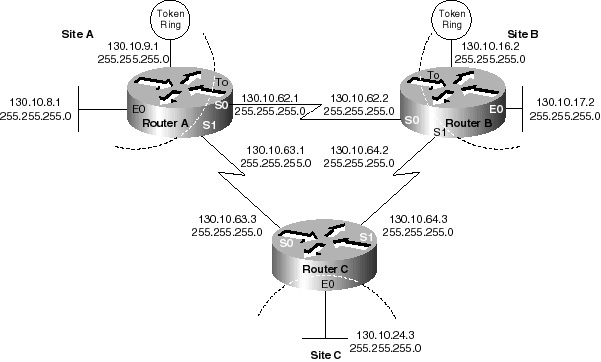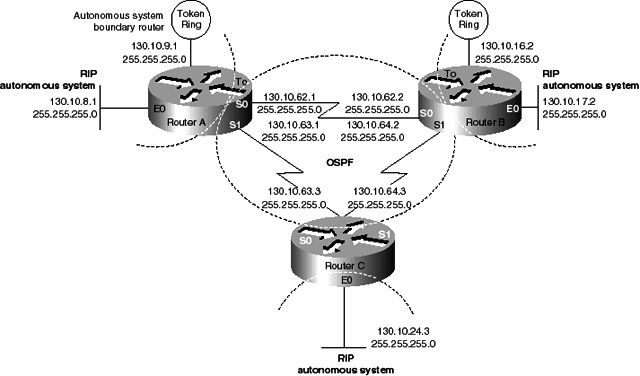Advanced OSPF Design Concepts
%OSPF-3-UNKNOWNSTATE Error MessageThe full text for this error message is as follows: %OSPF-3-UNKNOWNSTATE: Reached unknown state in neighbor state machine Explanation: An internal software error occurred. Recommended Action: Copy the error message exactly as it appears, and report it to your technical support representative. %OSPF-4-VIRTUAL_IN_NON_BACKBONE Error MessageThe full text for this error message is as follows: %OSPF-4-VIRTUAL_IN_NON_BACKBONE: Virtual link information found in non-backbone area: [chars], OSPF_COMPLAIN_IVL Explanation: An internal error occurred. Recommended Action: Copy the error message exactly as it appears, and report it to your technical support representative. Chapter SummaryThe whole section on redistributing OSPF routes both into and out of your OSPF network is designed to once again cover the rules regarding their use and configuration. The chapter then moved into practical low key examples and, as the solid foundation was built, began exploring the tougher aspects of this concept. The chapter also followed a very similar principle when dealing with the capability of OSPF to operate within a demand-based circuit environment. This time, though, you learned about both optimal and less-than-optimal network designs. The remaining sections of this chapter gave ideas concerning how router commands should be presented for use. The various OSPF configuration commands and error messages have been presented in as much of a down-to-earth fashion as possible and organized in such away that you will be able to quickly reference them while working online. This last section is a case study and presents the classic RIP and OSPF Redistribution case study. This chapters contains the contributions of previously existing sources published by Cisco. Many of the sources do not credit authors and such, but everyone involved at Cisco who ensured that a strong internal support framework was built for their products made write this chapter much easier. Case Study: RIP and OSPF RedistributionThis case study is a classic for those making the transition from RIP to OSPF. It has become extremely popular within networking circles, and I felt it should be reproduced here for everyone. It has been modified and updated slightly, but otherwise the original text and message is identical to when it was a Cisco case study. This case study addresses the issue of integrating RIP networks with OSPF networks. Most OSPF networks also use RIP to communicate with hosts or to communicate with portions of the internetwork that do not use OSPF. Cisco supports both the RIP and OSPF protocols and provides a way to exchange routing information between RIP and OSPF networks. This case study provides examples of how to complete the following phases in redistributing information between RIP and OSPF networks:
Configuring a RIP NetworkFigure 6-14 illustrates a RIP network. Three sites are connected with serial lines. The RIP network uses a Class B address and an 8-bit subnet mask. Each site has a contiguous set of network numbers.
Table 6-3 lists the network address assignments for the RIP network, including the network number, subnet range, and subnet masks. All interfaces indicate network 130.10.0.0; however, the specific address includes the subnet and subnet mask. For example, serial interface 0 on Router C has an IP address of 130.10.63.3 with a subnet mask of 255.255.255.0. Configuration File Examples The following commands in the configuration file for Router A determine the IP address for each interface and enable RIP on those interfaces:
Router A Configuration interface serial 0 ip address 130.10.62.1 255.255.255.0 interface serial 1 ip address 130.10.63.1 255.255.255.0 interface ethernet 0 ip address 130.10.8.1 255.255.255.0 interface tokenring 0 ip address 130.10.9.1 255.255.255.0 router rip network 130.10.0.0 The following commands in the configuration file for Router B determine the IP address for each interface and enable RIP on those interfaces: Router B Configuration interface serial 0 ip address 130.10.62.2 255.255.255.0 interface serial 1 ip address 130.10.64.2 255.255.255.0 interface ethernet 0 ip address 130.10.17.2 255.255.255.0 interface tokenring 0 ip address 130.10.16.2 255.255.255.0 router rip network 130.10.0.0 The following commands in the configuration file for Router C determine the IP address for each interface and enable RIP on those interfaces: Router C Configuration interface serial 0 ip address 130.10.63.3 255.255.255.0 interface serial 1 ip address 130.10.64.3 255.255.255.0 interface ethernet 0 ip address 130.10.24.3 255.255.255.0 router rip network 130.10.0.0 Adding OSPF to the Center of a RIP NetworkA common first step in converting a RIP network to an OSPF network is to add backbone routers that run both RIP and OSPF, while the remaining network devices run RIP. These backbone routers are OSPF ASBRs. Each ASBR controls the flow of routing information between OSPF and RIP. In Figure 6-15, Router A is configured as the ASBR.
RIP does not need to run between the backbone routers; therefore, RIP is suppressed on Router A with the following commands: router rip passive-interface serial 0 passive-interface serial 1 The RIP routes are redistributed into OSPF by all three routers with the following commands: router ospf 109 redistribute rip subnets network 13.10.0.0
| ||||||||||||||||||||||||
EAN: 2147483647
Pages: 200

